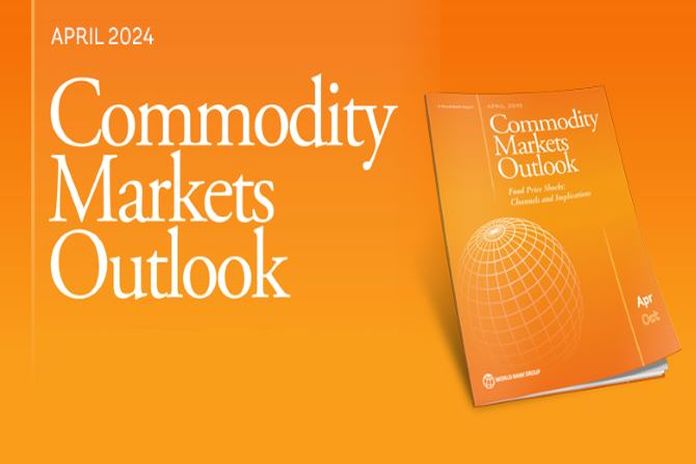Global commodity prices level off, hurting prospects for lower inflation

- Major flare-up in Middle-East conflict could stoke global inflation
WASHINGTON, USA – Global commodity prices are levelling off after a steep descent that played a decisive role in whittling down overall inflation last year, which could make it harder for central banks to cut interest rates quickly, according to the World Bank’s latest Commodity Markets Outlook. The report also finds that a major outbreak of conflict in the Middle East could halt the inflationary decline that has occurred over the past two years.
Between mid-2022 and mid-2023, global commodity prices plummeted by nearly 40 percent. This helped to drive most of the roughly 2-percentage-point reduction in global inflation between 2022 and 2023. Since mid-2023, however, the World Bank’s index of commodity prices has remained essentially unchanged. Assuming no further flare-up in geopolitical tensions, the Bank’s forecasts call for a decline of 3 percent in global commodity prices in 2024 and 4% in 2025. That pace will do little to subdue inflation that remains above central bank targets in most countries. It will keep commodity prices about 38 percent higher than they were on average in the five years before the COVID-19 pandemic.
“Global inflation remains undefeated,” said Indermit Gill, the World Bank Group’s chief economist and senior vice president. “A key force for disinflation – falling commodity prices – has essentially hit a wall. That means interest rates could remain higher than currently expected this year and next. The world is at a vulnerable moment: a major energy shock could undermine much of the progress in reducing inflation over the past two years.”
Persistently high geopolitical tensions over the past two years have propped up the price of oil and many other critical commodities even as global growth has slowed. The price of Brent crude oil, for example, surged to $91 per barrel earlier this month – nearly $34 per barrel above the 2015-2019 average. The bank’s forecasts indicate that Brent prices will average $84 per barrel in 2024 before declining to an average of $79 in 2025, assuming no conflict-related supply disruptions. If the conflict in the Middle East were to escalate further, however, oil supply disruptions could push up global inflation. A moderate conflict-related supply disruption could raise the average Brent price this year to $92 per barrel. A more severe disruption could see oil prices surpass $100 per barrel, raising global inflation in 2024 by nearly one percentage point.
“A striking divergence is emerging between global growth and commodity prices: despite relatively weaker global growth, commodity prices will most likely remain higher in 2024-25 than in the half-decade before the COVID-19 pandemic,” said Ayhan Kose, the World Bank Group’s deputy chief economist and director of the prospects Group. “One critical factor behind this divergence relates to heightened geopolitical tensions that are keeping upward pressure on prices of major commodities and stoking risks of sharp price movements. Central banks must remain alert about the inflationary implications of commodity-price spikes amid elevated geopolitical tensions.”
The average price of gold – a popular choice for investors seeking “safe haven” – is expected to hit a record in 2024 before moderating slightly in 2025. Gold holds a special status among assets, often rising in price during periods of geopolitical and policy uncertainty, including conflicts. Strong demand from several developing-country central banks, along with heightened geopolitical challenges, is expected to bolster gold prices throughout 2024.
An escalation of the conflict in the Middle East could also drive up prices of natural gas, fertilizers, and food, the report notes. The region is a crucial gas supplier – 20 percent of global liquefied natural gas (LNG) trade transits the Strait of Hormuz. If the LNG supply were interrupted, fertilizer prices would also rise substantially, likely driving up food prices. The Bank’s baseline forecast, however, is for overall food prices to decline somewhat, by 6 percent in 2024 and 4 percent in 2025. Fertilizer prices are expected to fall by 22 percent in 2024 and 6 percent in 2025.
Accelerating investment in green technologies has bolstered prices of key metals that are critical for the global clean-energy transition. Prices of copper, necessary for electricity grid infrastructure and electric vehicles surged to a two-year high this month. They are expected to rise 5 percent in 2024 before stabilizing in 2025. Prices of aluminium are forecast to rise by 2 percent in 2024 and 4 percent in 2025, bolstered in particular by the production of electric vehicles, solar panels, and other renewable-power infrastructure.
The report also contains a special focus section evaluating the performance of five well-known approaches used to forecast the prices of three key commodities – rude oil, copper, and aluminium. It finds that each of them suffers from certain deficiencies, but each also offers important advantages. As a result, the analysis suggests, forecasts are most accurate when they reflect a variety of analytical approaches and a healthy dose of judgment.
Source: caribbeannewsglobal.com

